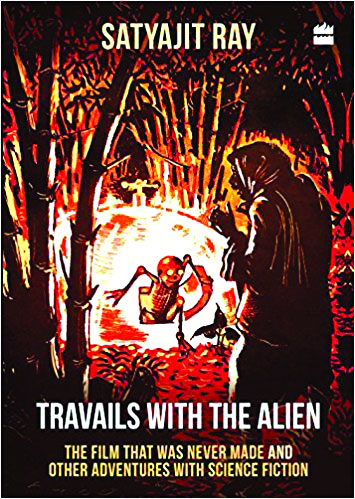Travails With The Alien gives a fascinating yet saddening account of how Satyajit Ray was set to make the first science fiction movie on and from India but could not, writes ANUBHAV PRADHAN
If you like intrigue, conspiracy, and trivia tinged with quirky originality, then Travails with The Alien is the book for you. The latest print offering from the Society for the Preservation of Satyajit Ray Archives, Travails with The Alien: The Film That Was Never Made and Other Adventures with Science Fiction is provoking, insightful, and fun. It is an engaging exploration into film history which is guaranteed to delight cinema buffs in India and abroad.
The premise is simple. In 1967, Satyajit Ray penned down the treatment for a unique science fiction movie. Set in rural Bengal, amidst the familiar clash of tradition and modernity in the form of a deeply hierarchical village community and a slyly manipulative industrialist, the story of The Alien plays upon the limitations put on human understanding and agency by hubris. Admittedly, in 2018 this story appears both simplistic and undercooked: The tradition-modernity confrontation is a little too done-to-death to appeal to contemporary audiences, even with a cheekily cordial extra-terrestrial thrown in. Yet, it’s important to remember that The Alien is a unique concept for its time and that in the mid-1960s nothing like it existed on celluloid. Planned as a bilingual project, in both Bangla and English, it was to be not just the first science fiction movie on and from India but also the first to humanise the subject of extra-terrestrial interaction by making the alien not an invader, a source of grave threat, but a friendly, curious traveller. Ray’s film was to be a big-ticket international affair, backed by Columbia Pictures and billed to star major Hollywood actors. Coming soon after the success and acclaim of the ‘Apu Trilogy,’ The Alien was poised to transform Ray as a pioneer of science fiction with a truly global footprint.
Alas, this was not to be. Despite favourable responses from Columbia and leading Hollywood actors like Peter Sellers, Marlon Brando, and Steve McQueen, The Alien got embroiled in legal complications which made it impossible for either Columbia or Ray to proceed. These originated largely due to the intractability of Michael Wilson, Ray’s supposed producer and alleged co-author for the project. With Wilson appropriating all the considerable advance of $15000 without Ray’s knowledge and then refusing to clearly relinquish claims to the script, Ray was eventually left with little choice but to let the affair fizzle down to slow, painful obscurity. Connecting the dots amongst dramatis personae dispersed in Calcutta, Colombo, Los Angeles, Paris, and London, Travails with The Alien curates a retrospective on these vexed and tiresome events which grounded the film even before it could take off to its promised and promising start.
While this is the central concern of the book, Travails with The Alien is not really a piece of film detection. It does more than just put together the various players in this forgotten saga. It also contextualises The Alien within Ray’s oeuvre, not just as a director but also as an illustrator, writer, thinker, and science fiction aficionado. Present along with the treatment of The Alien are “Bonkubabu’s Friend” (1962), the short story in Sandesh which is supposed to have been a literary prototype for the movie, a few essays on science fiction and cinema by Ray, interviews of Ray on science fiction and on The Alien, and a feature, “Ordeals of The Alien”, written by Ray for The Statesman in 1980. These and other pieces in the book are liberally sprinkled with photographs, scanned copies of correspondence, and excerpts from newspapers during the three-year period from 1967 to 1969, when the fortunes of The Alien were a matter of public speculation. These nuggets from the Ray Archives make Travails with The Alien an appetising insight into Ray’s abiding engagement with the transgressive potential of adventure and exploration on the human soul: The infinite possibilities of technological advancement acting upon the human condition as he knew and understood it.
One of the chief delights of the book, however, is its presentation. No effort seems to have been spared in the reproduction in colour of Ray’s illustrations on science fiction and space travel, and the documents on the Sci-Fi Cine Club evoke a charming sepia nostalgia of a fandom before fandom. Sandip Ray, the editor, and his associates Dhritiman Chaterji, Arup K De, Riddhi Goswami, and Deepak Mukherjee deserve thanks and congratulations for so carefully and tastefully compiling and arranging the very many archival documents which constitute the lasting visual appeal of the book. Scholars of Ray and of Bangla cinema will obviously find Travails with The Alien a rare treat, as will fans of Ray’s films and writings.
The reviewer is a Doctoral Candidate with the Department of English, Jamia Millia Islamia. The views expressed here are his own


























